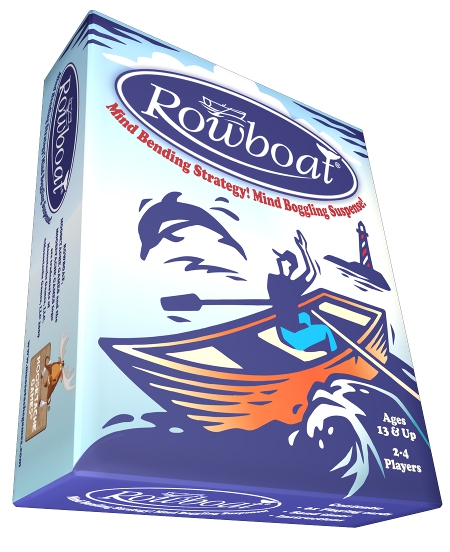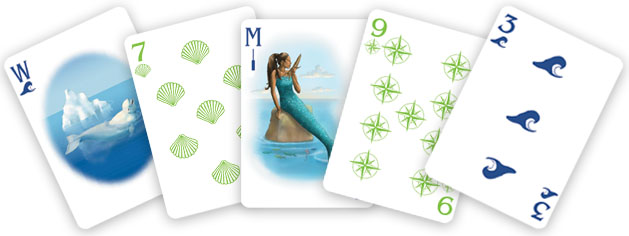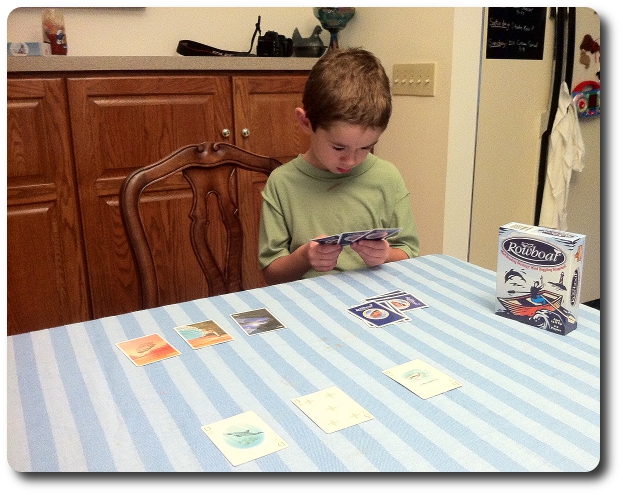
The Basics:
- For ages 13 and up
- For 2 to 4 players
- About 60 minutes to complete
Geek Skills:
- Counting & Math
- Logical & Critical Decision Making
- Strategy & Tactics
- Pattern/Color Matching
- Risk vs. Reward
- Hand/Resource Management
Learning Curve:
- Child – Moderate
- Adult – Easy
Theme & Narrative:
- While the game is very heavily nautical themed, it does nothing more than provide the backdrop for the game itself and has no significant importance or impact to the game other than being sailorific.
Endorsements:
- Gamer Geek approved!
- Parent Geek approved!
- Child Geek rejected!
Overview
Rowboat is a heavily nautical themed tick-taking card game that is playable with 2 to 4 players. This game is challenging and will require the players to think hard about their moves if they are going to sink, swim, or float above the rest to victory (see what I did there?).
Rowboat is comprised of 61 cards of four suits: Maps, Oars, Shells, and Waves. A complete suit contains 13 cards. From weakest to lowest: Anchor, card number values 2 through 9, Dolphin, Mermaid, Seeker, and Whale. In addition, there are three special cards: Rowboat, Lighthouse, and Moon. Last, a 60 second sand timer is included for use with the special card, the Lighthouse. All the game components are of high quality and durable which will provide you, your friends, and your family with many hours of fun. What is not included, but will be needed to play the game, is a piece of paper and a pen or pencil to keep score.

To set up the game, remove the 3 sets of special cards (Rowboat, Lighthouse, and Moon). If playing a 2 or 3 player game, each player receives 1 set of special cards. If playing a 4 player game, divide the 4 players into two teams of two and each team is receives 1 set of special cards. The rest of the cards, except the special cards, should now be shuffled and the sand timer set to the side for easy reach when needed. Decide which player should go first to become the Dealer and begin the game.
The Tide
The Dealer will always reveal the Tide at the beginning of the hand. Within that hand, the players might have the opportunity to try to take as few as 4 or up to a maximum of 12 tricks (for a 2 or 3 player game) or to a maximum of 10 tricks (for a 4 player game). To determine the size of the Tide, the Dealer takes the deck of cards and reveals one card at a time until 1 of each suit is showing.
The Moon special card allows the Dealer to control the size of the Tide and only once. When the Dealer uses the Moon card, it is removed from the game immediately. Once played, the Dealer announced the size of the Tide and deals out that many cards. The Tide can be as small as 4 card but never any larger than the maximum which is determined by the number of players in the game. Again, if playing with 2 to 3 players, the maximum Tide size is 12. For a 4 player game, the maximum Tide is 10.
The Tide determines two things in the game. First, the number of tricks available to all players in the hand. Second, each card in the Tide determines the trick’s trump card.
The Deal
After the Tide has been revealed, the Dealer gives a number of cards equal to the Tide to each player. For example, if the Tide is 5 cards, each player is dealt 5 cards.
The Exchange (4 players only)
If playing a 4 player game, each team of 2 can now pass one card to their partner. Partners cannot discuss their strategy at the table or discuss what cards to pass. The only exception is for the use of the special cards. Partners can discuss when they should be used at anytime in the game as appropriate.
The Bid
Note: Bidding is an optional rule! If you are playing with younger little geeks or individuals who are not familiar with the bidding mechanic, consider not using it until everyone understands and is comfortable playing Rowboat. Bidding adds a great deal more complexity and depth to the game, making it difficult for card game novices.
The players now determine how many tricks they can take based on the cards in their hand and what cards are shown in the Tide. The number of tricks taken will award the player with points, but the player must get the exact number of tricks they predict or be penalized.
When determining the bid, the players must take into account the suit of each card in the Tide. In addition, they must also take into account the strength of the cards in their hand. The strength of each card, from strongest to weakest, follows:
- Rowboat: one of the three special cards, the Rowboat always wins the trick it is played on. The Rowboat cannot be played on the last trick of the Tide, cannot beat another Rowboat, and is lost to the player for the duration of the game once played.
- Knobs: a card with the same value and the same color as the Tide card.
- Trump: a card that matches the suit of the Tide card.
- Off-Colored Knobs: a card with the same value but different color as the Tide card.
- Non-Trump: any card that is not one of the above.
Let’s Play!
For the first trick of the Tide, the player to the Dealer’s left plays their card first, followed by the next player to their left until everyone in the game has played one card. A player must always play to the Tide’s suit if they can. The only exceptions is playing the Rowboat or keeping a Knob for play later in the Tide.
The player who wins the trick collects the cards and deals the first card on the next trick. Play continues until all the tricks in the Tide have been taken.
If at any time there is no winner of the trick, play continues with the next trick as normal. Except, when the player wins the trick, they not only take the winning trick, but all tricks that were tied before it, too!
Scoring
Once all the tricks in the Tide of been taken, the players count the number of total tricks they took. If not playing with the bid, each player takes the number of tricks they won and multiplies it by 10. For example, taking 5 tricks would award the player 50 points.
Playing with the bid changes how you count points and can greatly impact the player negatively if the bid was not done correctly.
- If the player took fewer tricks then what they bid, reduce the player’s score by the number of tricks they said they would take, times 10. For example, if the player said they would take 4 tricks, but only took 3, the player’s total score so far is penalized (reduced) by 40 points (4 x 10 = 40).
- If the player took exactly the number of tricks they bid, award the player with the number of trick, times 10. For example, if the player said they would take 4 tricks and had that number of tricks exactly by the end of the Tide, the player is awarded 40 points (4 x 10 = 40).
- If the player took more tricks then they bid, award the player with the number of trick bid, times 10, in the same way you would score for making your bid exactly. However, for every trick taken past the bid, add one “sandbag”. For example, if the bid was 4 and the player takes 6 tricks, the total number of sandbags is 2 (6-4 = 2). If a player ever has 5 or more sandbags, their total score is penalized (reduced) by 100 immediately!
In summary…

Winning the Game
The winner of the game is the first player or team (if playing with 4 players) to 200 points. Teams add their points together.
Special Cards
In total, there are three special cards in the game. Once played, the cards are removed for the duration of the game. The special rules for each follow:
- Rowboat: always wins the trick it is played on. The Rowboat cannot be played on the last trick of the Tide, cannot beat another Rowboat, and is lost to the player for the duration of the game once played.
- Lighthouse: allows the player to look at all the other player’s hand for 60 seconds each (use the timer).
- Moon: allows the dealer to set the number of cards in the Tide before dealing.
A video tutorial is also available to you if you are a visual learner.
Prediction
Rowboat is a much more complicated game than my oldest little geek is used to. To date, he’s mastered Go Fish, Crazy Eights, Old Maid, his Chimpooki card game (created using Pentology), Slap Jack, and Duck Duck Bruce!, but none of these card games have a complex trick taking or bidding mechanic. Playing to a card’s suit, number, or color is familiar to my little geek, but these game mechanics have only been played at the most basic of levels. Additionally, Rowboat’s bidding rule is simply too complex for my little geek to grasp at this time in his early Gamer Geek career. I give him one more years, tops, before he can really tackle bidding in a way that would allow him to be competitive.
After giving it much thought, I decided to go for it and teach my little geek the game, even though the recommended age is 13+. However, I have said many times before that the age range on the game box is nothing more than a general suggestion on what age groups might have the necessary geek skills to play the game well. Emphasis on the might, as I know 40 year olds who still cannot grasp Settlers of Catan which is a game designed for ages 10 and up. If a parent is willing to work through the rules of the game, is patient, and encouraging, you can teach your little geek anything.
Turns out that teaching the basics of the game wasn’t that big of a deal. My little geek quickly grasped the significance of the Tide and how the cards should be played to win tricks. The card conditions for Knobs and Off-Colored Knobs was a problem for my little geek initially until I created a visual aid to help him remember. We also played several hands open so he could see how I was playing my cards, talking through each decision made. Once we completed several tricks, and he felt he was ready, we took the cards, shuffled them and got ready to play the game. Before doing so, I asked my little geek his thoughts on Rowboat. His response:
“This looks like a hard game, but I understand how to win cards. I don’t think I’m going to win, but you are not going to take all the tricks, Dad!” ~ Liam (age 7)
What spunk! You gotta love it when your little geek looks a challenge right in the eye and says, “bring it!”
Final Word
Rowboat is a surprisingly complex card game that keeps me coming back for more. Unlike other trick taking games, you already know what you are going to play to in the Tide which makes it easier to bid. However, the other players also know about the Tide, which makes bidding something of a game of “Cat and Mouse”…or is it “Chicken”? Either way, the level of competition to out-think and out maneuver your opponent is incredibly challenging and fun! I have tried Rowboat with and without the bid mechanic and HIGHLY suggest that any self respecting Gamer Geek play with the bid right out of the box. You will be rewarded with a quick card game that will challenge your critical and logical thinking and any semblance of strategy or tactics you might have learned with other card games.
A little geek’s game, however, this is not. I think Rowboat is too abstract for a young mind to grasp. The game itself it really played in the mind as you attempt to out-think your opponent and then play the hand out, making subtle corrections as you go. This depth was completely lost on my little geek and he only thought about his next trick, matching cards as he went, instead of thinking more long term. This is not a knock on the game whatsoever, but I do agree with the recommended age on the box. I think my oldest little geek will be able to play the game better next year or the year after, but right now, there is too much going on in the game for him to really enjoy it. As such, Rowboat was rejected by my little geek for games more his speed and geek skill level.

My little geek understood the basics, but the game was just a little too complex for him
For the Parent and Gamer Geeks, though, Rowboat is going to be a treat! Not in a long while has a card game got me thinking so hard or has felt so rewarding when you pull off your bid. The special cards add an interesting twist that can really make a difference in the game if played correctly and at the right time. I’ve played many, many different trick taking games in my day, but there is just something about Rowboat that works very well. You will also find that Rowboat will be a welcomed game for those family members who enjoy the more complex card games like Cribbage and Bridge, but do not consider themselves Gamer Geeks.
The only part of the game I do not like is the limit to 3 sets of special cards in the box. Yes, the 4 player version of the game shares a set between two players, but a think providing 4 sets would make for a very interesting 4 player, non-team game. A simple enough correction, of course. Just create three special cards for the fourth person, which I have done. A 4 player, non-team game is terribly cutthroat and lots of fun, but of course, much longer. It is the increased game length that might have been the deciding factor on making a 4 player game a team experience.
Rowboat was also very popular at Gen Con 2011, complete with a 3 day tournament, and was a runner up for the 2011 Family Card game award. See? I’m not the only one who likes it.


Like the game? Get yourself a copy and save some cash! Use the following special promotional code, “HOLIDAY”, courtesy of Moosetache Games.

This game was given to Father Geek as a review copy. Father Geek was not paid, bribed, wined, dined, or threatened in vain hopes of influencing this review. Such is the statuesque and legendary integrity of Father Geek.




Pingback: Father Geek » New Giveaway: Hike and Rowboat Card Game Giveaway!
Pingback: Moosetache Games | Hike makes it on Father Geeks Top 5 Games Played in 2011 + More Game Reviews!
Would love to have the written German rules for this game. Can’t find on boardgamegeek or anywhere.
No, it doesn’t look like they exist. You might next want to try contacting the game company directly using their contact form. Good luck!
Would love to see a copy of the visual aid you made if you still have it?
Thanks for the review! Would love to see a copy of the visual aid you made if you still have it?
I’m afraid I don’t. All our players have long since been able to remember how the game is played and how to score.